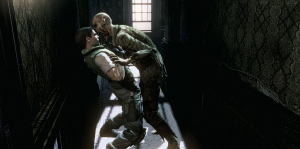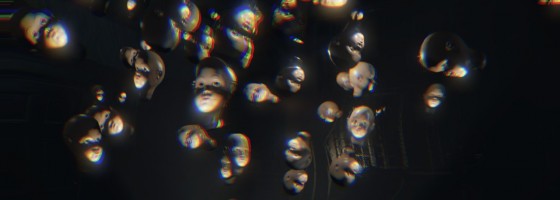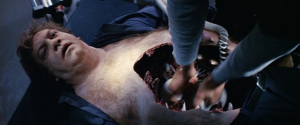Recently I played the horror game Layers of Fear that like Five Nights at Freddy’s has become another Indie darling among Youtubers and watchers for its “fear.” For me however, things are different; I found the game to be as boring as the Five Nights series and the reason has to do with jump scares. The use of jump scares has grown with the rising popularity of streamers, and for today’s post, I want to talk about why I think they’re a determent to the horror genre.
Defining Tension:
This next part should be familiar to long time readers of the Game-Wisdom, but it’s important to talk about and define what tension is when it comes to the horror genre. Excellent examples of horror both in video game and other mediums are all about the balance between the two parts of tension: The build up and the release.
The buildup is the period where the viewer is on edge; they know something is about to happen, they just don’t know when. The release is of course when things hit the fan: The monster shows up, the person dies, etc. In order for tension to work, both the build up and the release need to happen in that order and under the right conditions.
Too much build up and the person will calm down and get bored; too much release and the person will become conditioned and not be frightened by anything else. With that said, there is one special note that I want to touch on before we go on.
By their designs, horror movies and video games are different when it comes to tension. The reason is that in a movie the audience has omniscient view of what’s going on, whereas in a video game they don’t.
When watching Nightmare on Elm Street, part of the charm of the series is watching Freddy toy with his victims and set up fake scares for the audience before he strikes for real.
In a video game, because the player is also the audience, you have to be careful with showing too much; if the player knows that there is an enemy ahead, they’re going to be ready for a fight and not feeling scared.
This is why the use jump scares have become a popular tool among Indie developers as of late, because they’re a way to scare the player without giving them warning and providing that balance between scenes where the player is strong or on edge and releasing the tension.
When used intelligently, a jump scare can be both an effective release of tension and an important part of a game, and there are a few examples of that.
Getting Jumpy:
Jump scares by their design are meant to be a one-time use; something unexpected to catch everyone unaware. Some of the most memorable horror scenes in video games are of the jump scare variety. Raise your hand if the dogs jumping through the window in Resident Evil scared you.

Resident Evil 1 has the infamous jump scare, but its use also served an important game design element
What’s great about that incident is that it worked on two levels. From a horror standpoint, the developers caught the player with their pants down; they weren’t expecting an attack in an empty hallway.
The other reason is that it presented a gameplay concern: Now the developers are saying that enemies can appear from outside the environment to attack the player.
That message changes the game moving forward. The player now has to think whenever they enter a new room, “Is something going to attack from a window?” In turn, the player is now causing their tension to rise on their own without any further need from the developer.
Going back to the first part of this post, this is one area where video games do excel compared to other mediums in horror. A video game is the only horror medium where the audience becomes their own worst enemy. You can make the player get into their own head and cause them to react even stronger to passive elements.
One of the most effective jump scares that I ran into was in Fatal Frame 3. The game introduces the concept of a safe area early on, but then breaks it in a sense with passive ghosts starting to appear. The first time that happened was when a ghost simply walked into the frame and left without any warning whatsoever. When that happened, I didn’t jump, but clenched my chest as my heart started racing a mile a minute.
When used correctly, a jump scare can provide a moment of catharsis or add to the design, but when used frequently, they become a cheap and overused gimmick that runs out very quickly.
Boo! Times infinity:
Jump scares are only meant to occur rarely in horror; at some point, the main plot or situation needs to happen: Jason goes on his rampage, Pinhead starts shooting chains at people, etc. When your experience is nothing but jump scares, the game is cheapen as a result.
Mentioned at the top, both Layers of Fear and Five Nights have built their games entirely around jump scares; with limited interaction on the player’s front. There are two key details as to why an experience with nothing but jump scares doesn’t work, and we’ll start with tension.

Jump scares by themselves cannot make a horror game and are too limited in their functionality to build up and release tension
As we talked about, the correct use of tension requires both a period of building up and then release in order to work properly.
In games built on nothing but jump scares, there is no build up of tension as jump scares occur without warning.
Once you’ve had one jumps care, it mentally prepares you for future ones; limiting their effectiveness over time. A good jumps care is one that comes out of nowhere and doesn’t overstay its welcome; as with the Resident Evil and Fatal Frame examples.
When you know that the entire experience is dependent on jump scares and nothing else, any tension that would have been created is lost, because you know what to expect.
The first five minutes of Five Nights at Freddy’s can be scary; the rest of the time, I’m bored out of my mind, because I know what to expect.
Speaking of which, that’s the other major problem when your game is nothing but jump scares. Jump scares are built as conditionals in a video game; meaning that the player must do X in order for jump scare Y to occur. In traditional or untraditional horror titles, the player is engaged by the design and forced to react to a number of events.
In both Haunting Grounds and Alien Isolation, the player is actively being chased by an enemy; while there are set attacks, the rest of the time, the player is never sure when they will be attacked. This creates both the buildup of not knowing and reacting to every subtle cue, and then the release when the attack actually occurs.
But with jump scares, there is no variety or buildup; the player knows (or can figure out) what situations create the jump scares. In the Five Nights series, it doesn’t take long to figure out all the possible jump scares and their conditions. Going back to the previous point, once you know the conditions, you know when to expect a jumps care; killing any tension.
The only thing the jump scare is going to do at that point is annoy you with the standard sudden noises and screen effects. For me, that’s when a “horror” game moves from being scary to just plain annoying, and when that happens, the game is done.

Alien Isolation featured an antagonist who actively engaged the player; creating a different kind of tension compared to other horror games
To be fair to other games, many, many titles have in your face or obvious jump scares: The ever popular tactic of putting something important in the middle of a big room and then unleashing hell when the player moves over there.
However, good horror design has more than just jump scares; a jumps care should be a tool in the box of tricks, not the only one there.
The other major problem with nothing but jump scares is that you cannot design a long experience around them. While many critics called out Alien Isolation for taking a concept and stretching it too far, a lot of horror Indie titles only last a short time, as you can’t add a lot to a game built around jump scares only.
Moving Beyond the Jack in the Box:
I’m still somewhat mystified over the rising popularity of jump scare-focused titles, both from a design perspective and the fan base and Youtubers who love it. While the old-school days of pre Resident Evil 4 and Alone in the Dark may not sell today, the jump scare take on horror design does not have the legs to sustain, let alone grow the Horror genre.
The Horror genre is similar to RPGs in that they have gone through generational design shifts over the last 20 years, and in an upcoming post, I’m going to examine what horror design can still learn from the first generation.



